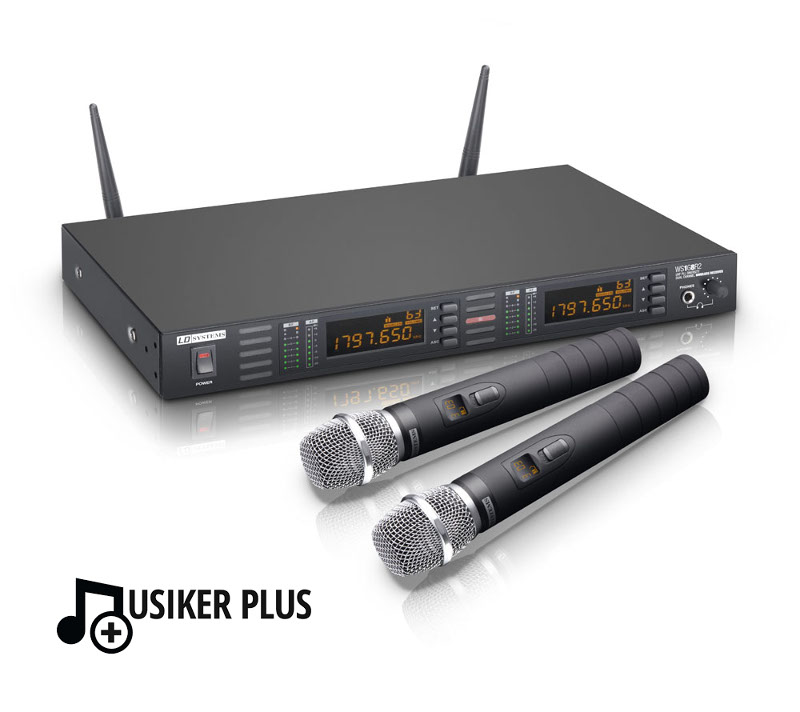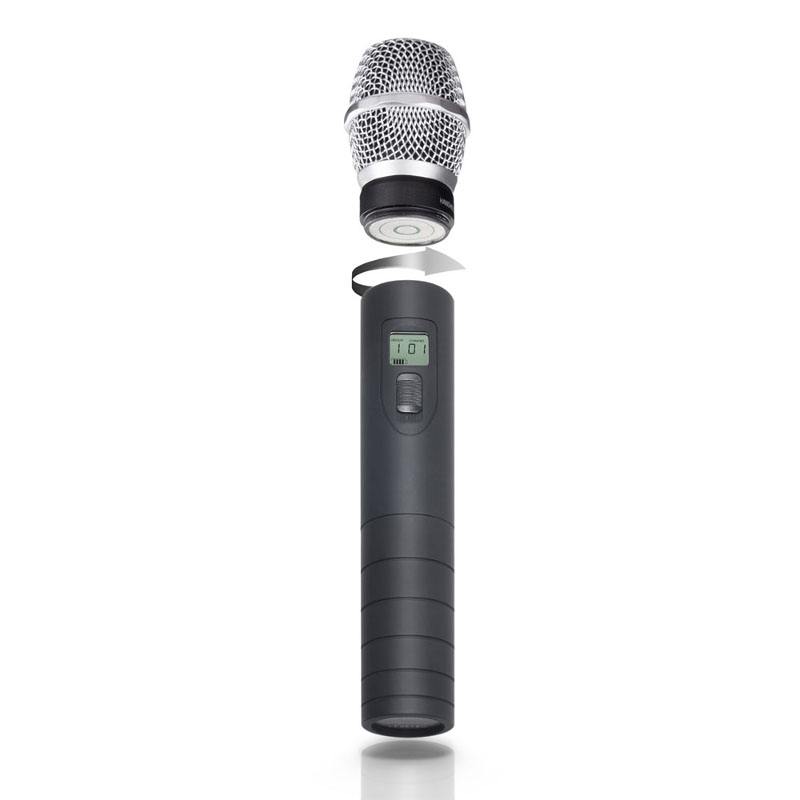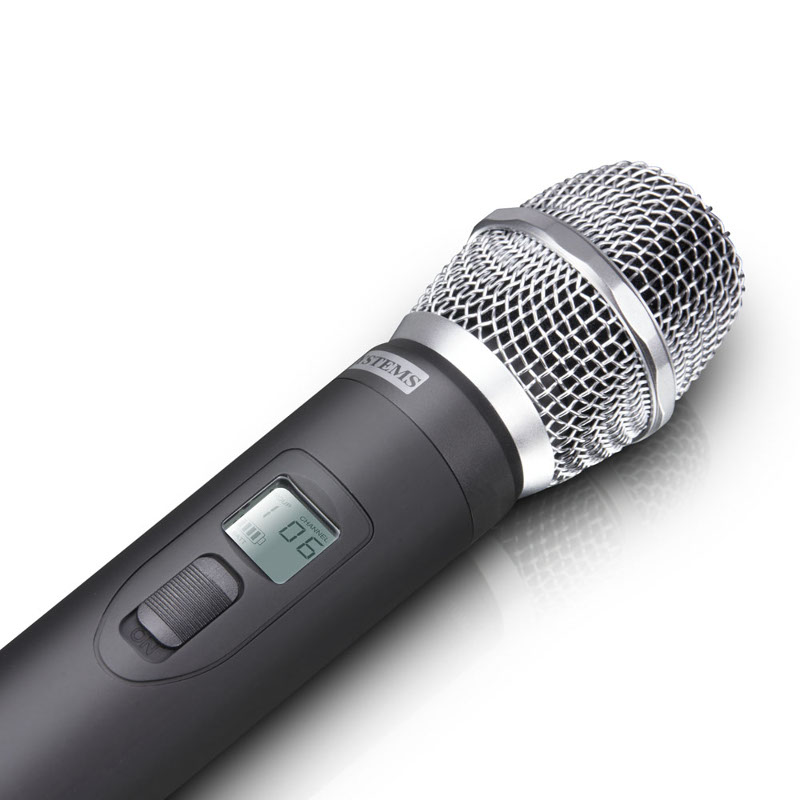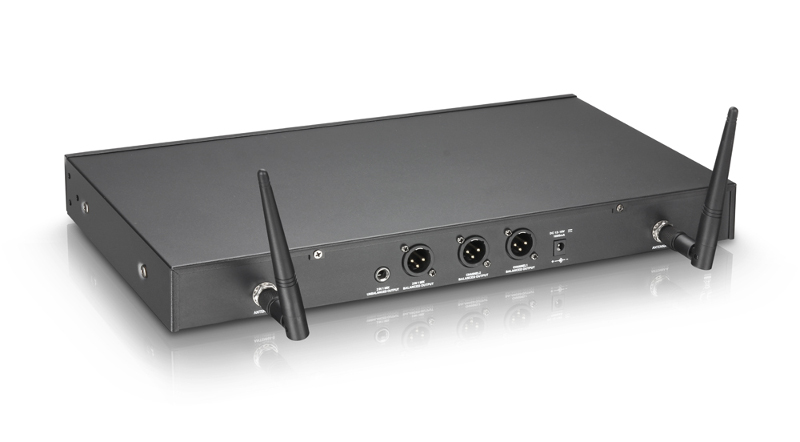LD Systems WS 1G8 HHC2 wireless system – LD wireless system with two condenser microphones – test report by musikerplus.de
In launching its WS1G8 series, LD Systems presents a range of wireless systems in the license-free 1.8 GHz band. This includes one and two-channel receivers, handheld microphones with a dynamic or condenser capsule and a bodypack transmitter suitable for not only lavalier microphones but also guitars and basses.

For today’s report, we tested the LD WS 1G8 HHC2, a system that comes with accessories in a robust plastic case and comprises a two-channel receiver in 19-inch format plus two handheld microphones with condenser capsules.
So, we open the case for our first look at the product. The first thing I go for is the instruction manual. And it’s good to see that a German version is provided! With regard to the receiver, I instantly notice that it comes ready for freestanding operation. The rack ears have not been attached, but are provided. The next thing I notice is the power connection: an external power adapter as is now the norm. LD Systems commendably supplies accessories for moving the TNC antenna connectors to the back of the rack or a panel to the front. The extension cables for this are about 50 cm long, which should suffice.
In addition to the aforementioned items, such as the rack ears, cables and screws, the second foam layer in the transport case also contains four AA batteries and two elegant handheld microphones. A matte, black enclosure, an on/off switch and a small display. No frills.
Using the LD Systems WS 1G8 HHC2
Next, it’s time to actually test the system in use. We screw together the microphones and insert two AA batteries into each one. This is all standard stuff. We then connect and switch on the receiver. As is to be expected from a two-channel receiver, two identical displays with identical controls light up. With their SET, up arrow, down arrow and ASC buttons, these are completely intuitive.

A quick press of the SET button results in… nothing. To prevent accidental actuation, you have to press and hold the button for about a second for it to do anything. Following this reflection period, the display switches to Group/Channel and Squelch.
LD Systems WS 1G8 HHC2 – 192 frequencies
The WS1G8R2 has 16 groups with twelve channels each, equating to 192 different frequencies. Once you have chosen a group, you can select one of the twelve channels or accept the illuminated ‘Auto’ option offered to you. In this case, the receiver ‘listens’ to the environment to determine which of the twelve channels is free or subject to the fewest interferences. This is extremely practical if you are operating several devices on the same frequency band.
The final configurable setting is squelch, which determines the noise reduction if the transmitter is switched off or out of range. This can set to L, M or H. Try it out. Providing you are not in SET mode, you can use the arrow buttons to adjust the channel volume. Great! Now we’ve set everything we need to. But what settings do I need to configure on the microphones for them to communicate with the receiver? None! The ominous ASC button is responsible for this.
An infra-red transmitter is located in the middle of the two displays on the receiver and a corresponding receiver is located on the base of the microphone. All you need to do is switch on the microphone, press the ASC button for the desired channel and hold the microphone 15 to 20 cm from the IR transmitter.
The ASC indicator on the display flashes, the microphone receives the necessary information in under five seconds and the field strength indicators point to maximum. The small display on the microphones only lights up for a few seconds after switching on the system, but this is long enough for you to see the channel set on the microphone and the battery capacity.

LD Systems WS 1G8 HHC2 – 13-hour battery life
If the batteries are low, this is not only indicated on the microphone but also on the display for the corresponding receiver. According to the data sheet, the batteries should last for 13 hours, but anyone who starts a gig without fresh batteries needs a seeing-to anyway!
Important: the microphone will remember the channel settings even after its batteries have been replaced. This means that the batteries can also be changed on stage if necessary, without having to re-pair the devices.
Incidentally, with regard to the displays: in addition to the LCD display for frequency, squelch and volume, each channel also has three LED chains with seven LEDS each. The chain labelled AF displays the respective channel’s audio signal; the two chains labelled RF display the reception strength of the two antenna channels; the WS1G8R2 is a true diversity receiver with two equal reception channels. The top LED indicates the channel that has currently been selected as active. It is not necessary for one receiver to select one channel and the second receiver to select the other; both receivers can use one and the same channel.
LD Systems WS 1G8 HHC2 – wireless
We now come to the wireless aspect of the system. According to the data sheet, the handheld transmitters have a transmission output of 10 mW. As a result of the extremely high frequency, the range is nominally far greater than with the previous systems, which also had an output of 10 mW at around 700 MHz. Naturally, the range depends on several factors as even 1.8 GHz systems are subject to physics.
It should be noted that the body absorbs high frequencies more quickly than lower ones. As such, particularly at larger distances, you should be careful not to unnecessarily block the transmitter by holding it in both hands or grasping it under your arm. Okay, so no-one actually sings like that anyway!
An endurance test for the LD Systems WS 1G8 HHC2
I was able to conduct an endurance test in my own office: my office microphone is of the cheapest kind and I’ve noticed on several occasions that it pollutes high frequencies. Microwaves are known to work at 2.4 GHz, which is not at all far removed from 1.8 GHz (at least if the device doesn’t work cleanly). However, the LD system wasn’t impaired by this – there was no reduction in reception performance and no interference. And so, if a performer chooses to heat up a bowl of soup on stage, it won’t cause any problems!
LD Systems WS 1G8 HHC2 outputs
Ah yes, the system naturally also has outputs. Balanced audio XLR is provided at three XLR sockets: channel 1, channel 2 and a mix of channels 1 and 2. There is also an unbalanced jack output with the mixed signal. Incidentally, the monaural mixed signal also applies at the adjustable headphone output at the front instead of one channel to the left and one to the right as I would have personally preferred.
And what’s the result? We’ve got the condenser version here, which is naturally somewhat bolder than the alternatively available dynamic version. In terms of the sound produced by the overall system, we can say that there is no trace of any interference, the inherent noise remains within very manageable limits and the data sheet refers to an S/N of over 90 dB. The frequency response is specified as 50 Hz to 16 kHz. All very pleasing.
What else did I notice? For an RRP of 599 euros, I would expect the microphone clamps to be included rather than having to purchase them separately for another 6.60 euros (RRP).

LD Systems WS 1G8 HHC2 summary
The LD Systems WS 1G8 HHC2 is a highly sophisticated and functional wireless system with two channels. It is quick and intuitive to operate, making it even suitable for beginners. The system is characterised by a clean sound and has no frills.
Overall review
of LD Systems WS 1G8 HHC2: 4.5/5
Sound: 5/5
Workmanship: 4.5/5
Range of functions: 3.5/5
Price: 5/5
Pros
+ sophisticated and functional
+ clean sound
+ suitable for beginners
+ good value for money
Cons
– microphone clamps should be included
__________________________________________
Source: musikerplus.de, Oct. 2015, Germany: http://musikerplus.de/buehne/ld-systems-ws-1g8-hhc2-wireless-system/
Author: Dirk Matschuk
For further information about the LD Systems WS 1G8 HHC2 wireless system, please visit:
http://www.ld-systems.com/en/series/ws-1g8-series/ws-1g8-hhc2-wireless-microphone-system-with-2-x-condenser-handheld-microphone/
Leave a Comment
You must be logged in to post a comment.












